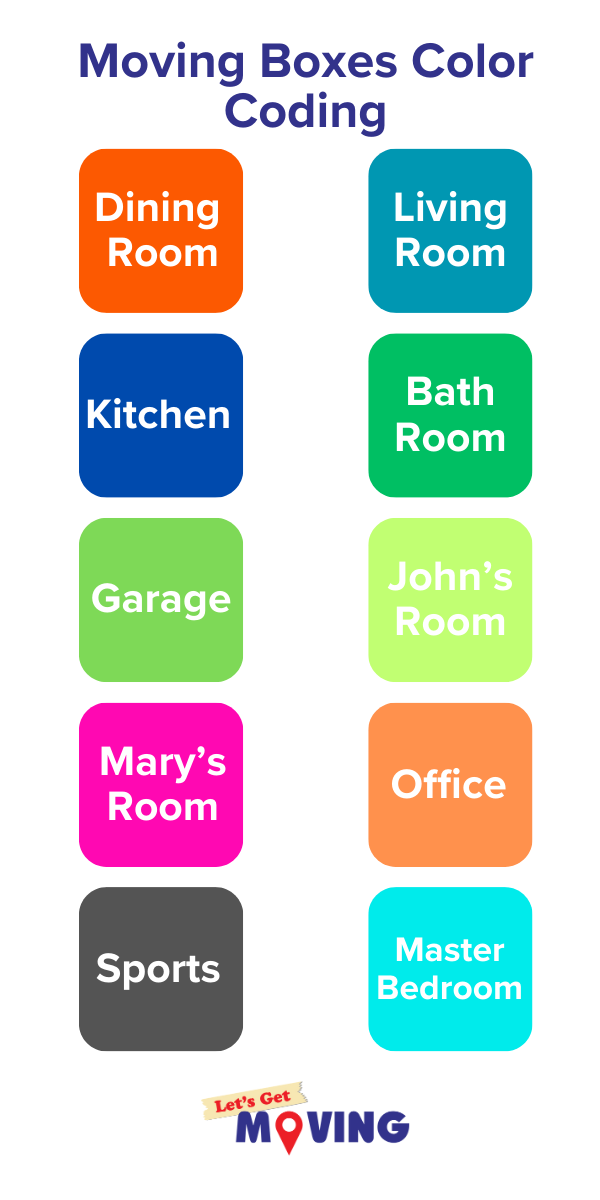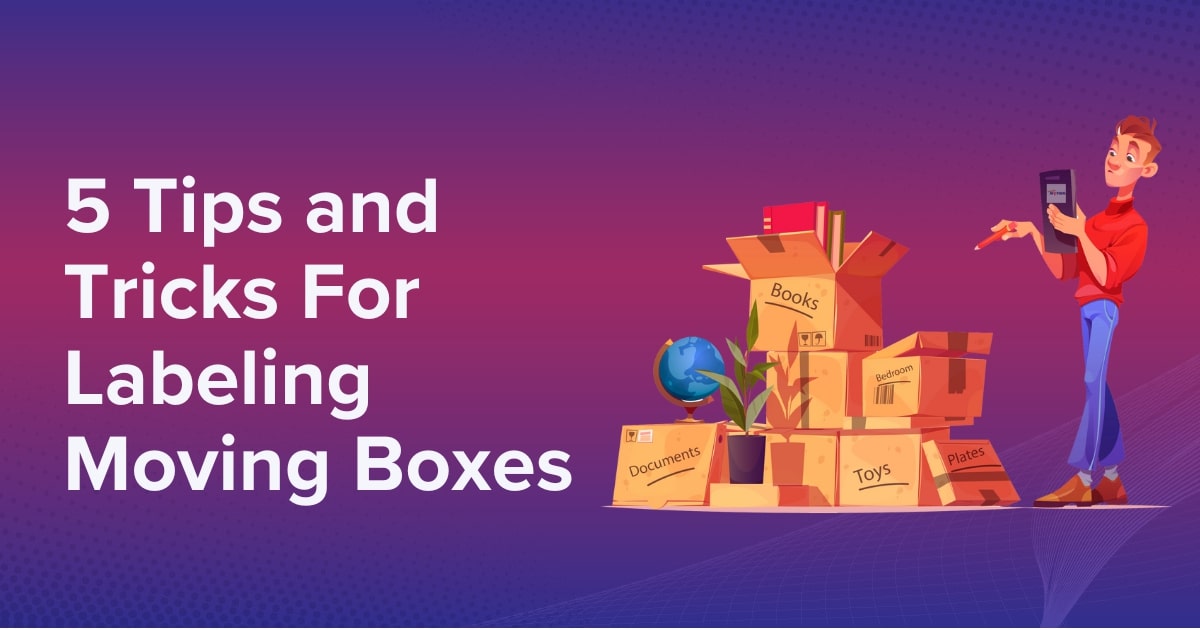Even the most organized people on Earth can use some moving box organization advice and efficient packing tips before a big move.
Labeling moving boxes is one of your best forms of communication with your moving company and anyone helping to move.
Using labels will help indicate heavy items that require extra muscle, fragile items that need additional care, feather-light items that can go on top of heavy items, and the daily necessities you’ll want to unpack first.
Labels also communicate which rooms each box should land in at their final destination, so your moving help requires less verbal direction on move day.
Read on to become an expert in labeling moving boxes like the pros at Let’s Get Moving.
Moving Soon? Let’s Get You Started on Labeling Moving Boxes
Moving to a new home or office is an exciting journey, and one of the keys to ensuring a smooth and stress-free transition is effectively labeling moving boxes.
As professional movers, we know good labeling is one of your best tools for communicating with your moving team during what can feel like a chaotic move.
Labeling moving boxes is not just about scribbling a name on a cardboard box; it’s a strategic process that, when done right, can transform your moving experience.
Even if you aren’t the most organized individual, this article will give you 5 essential tips and tricks for labeling your moving boxes, according to our expert movers in Miami, FL, and other locations.
Each tip we’re giving here for labeling moving boxes will streamline the packing and unpacking process, ensuring that your items are easy to find and safely transported to your new home or office.
From the art of color coding to the science of detailed descriptions, these labeling strategies are time-tested and mover-approved.
Whether you’re a first-time mover or a seasoned relocating veteran, these insights will help you organize your move like a pro, turning a potentially chaotic experience into a manageable and orderly transition.

Tip 1: Use a Color Coding System
Simple, practical, and surprisingly fun, labeling moving boxes is the best way of communicating with your moving team because you can’t be in all places simultaneously on the day of a move.
-
Choose Lable Colors Wisely
Start by selecting a different color for each room. For instance, you might use blue for the bedroom, green for the kitchen, and yellow for the living room.
Use bright, distinct colors to avoid confusion. (Moving days are confusing enough!) You can use colored stickers, markers, or even colored tape.
-
Labeling Moving Boxes: Location, Location, Location
Place your color labels on multiple sides of the box. This way, the color coding is always visible no matter how the boxes are stacked or turned. This detail is incredibly constructive when unloading and stacking boxes in your new home.
-
Supplement Moving Box Labels with Text
While colors are great for quick identification, they don’t provide specifics. Use a permanent marker to write a brief description of the contents of each box. For instance, “Kitchen: Utensils” or “Bedroom: Bed Linens.” This detail is handy when looking for specific items before you’ve unpacked.
-
Color coding is a Control Freak’s Best Friend, Post-Move
A color-coding system is aesthetically pleasing and a game-changer when labeling boxes for moving and keeping things labeled post-move.
Assign a specific color to each room in your new home to make it incredibly easy for you, your family, or your movers to identify where each box belongs at a glance.
Implementing a color-coding system might seem like a small step, but its impact on the moving process is significant.
It reduces the time spent directing traffic on a moving day and speeds up unpacking, as boxes go directly to their intended rooms.
Tip 2: Detailed and Descriptive Labels
While a color-coding system efficiently guides your boxes to the fitting room, the magic of a well-organized move lies in the details. Detailed and descriptive labels on each box can save you hours of searching and unpacking in your new home.
-
Be Specific When Labeling Moving Boxes
Be as descriptive as possible without being verbose when labeling your boxes.
For instance, instead of just writing “Kitchen,” specify “Kitchen: Pots and Pans” or “Kitchen: Everyday Dishes.” This level of detail helps you find what you need without opening multiple boxes.
-
Use the Right Tools to Label Moving Boxes Like a Pro
A permanent marker is your best friend when it comes to labeling. Choose waterproof and smudge-proof markers to ensure your labels remain clear and legible during the move.
Write on the sides of the boxes rather than the top so you can read the labels even when boxes are stacked.
-
Add a Contents List to Your Moving Boxes
Consider attaching a brief list of contents outside for boxes full of diverse items. This addition to our labeling tip can be handy for mixed-use boxes, such as items from different room areas.
By labeling your boxes with detailed descriptions, you not only make the unpacking process smoother but also reduce the risk of misplacing essential items.
Though this step may add more time to your packing process, it is invaluable in maintaining order and peace of mind during the chaos of moving.
Tip 3: List Contents and Handling Instructions
An essential aspect of labeling moving boxes is identifying where they go and guiding how to handle them. This tip is particularly crucial for items that are fragile, valuable, or require special attention.
-
Listing Moving Box Contents Clearly
When packing each box, take a moment to jot down the main items inside. It’s not an exhaustive list, but enough to indicate the contents well.
Example: If you are packing a bedroom, you may label the boxes: “Primary Bedroom: Bedding and Photo Albums.” This level of detail is beneficial, especially if you need to find specific items quickly after moving.
-
Adding Handling Instructions to Moving Boxes
As moving experts, we always recommend packing fragile items like crystal and stemware together.
If a box contains fragile items like glassware or electronics, clearly mark it with a “Fragile” label.
Similarly, if certain boxes should be kept upright or are heavy, labels such as “This Side Up” or “Heavy” are vital. These instructions communicate how to handle each box, reducing the risk of damage during the move.
-
Use of Symbols on Moving Boxes
Sometimes, a picture speaks louder than words. Using simple symbols like glass to indicate fragility or arrows to indicate which way is up can be quickly understood at a glance.
Draw these symbols with a marker or use pre-made stickers for uniformity and ease.
Incorporating content lists and handling instructions into your labeling system is not only a practical approach but also a considerate one.
It ensures that your belongings are appropriately handled and arrive at their destination in the same condition they left, offering peace of mind.
Tip 4: Use Labeling Tools Effectively
Your choice of labels can significantly affect your packing process’s efficiency and effectiveness. Selecting the suitable materials ensures your labels are durable, visible, and informative.
-
Use Good Markers (the Permanent Kind!)
Invest in high-quality, permanent markers for writing on your boxes. Look for waterproof and fade-resistant ones to withstand any weather conditions during the move. Bright, bold colors stand out better on cardboard.
-
Test Different Types of Labels
Consider other labeling tools like printed labels, colored tape, or stickers. Pre-printed labels can save time and offer a uniform look to your boxes.
Use colored tape because it can double as a label and a moving box seal. One of our Marietta Movers from Georgia recommends asking yourself: are the labels you’re using going to live through a rainy or very humid day?
-
Placement Matters for Labeling Moving Boxes
Where you place the labels on the box is as important as what you write. Always label on multiple sides of the box, at least one of the more prominent and top sides.
The communication is visible regardless of how the box is stacked or stored.
-
Reinforce Your Moving Box Labels
Our South Denver movers encourage clients to reinforce paper labels with clear packing tape.
This practice protects the label from damage and prevents it from peeling off during handling and transport.
Effective use of labeling tools not only aids in organization but also in preserving your labels throughout the moving process.
Choosing the right tools and using them wisely ensures that your labeling system remains intact from start to finish, making unpacking at your new home a breeze.
Tip 5: Keep an Inventory List Apart from Your Boxes
An inventory list acts as a master key to the contents of your moving boxes, adding an extra layer of organization and security to your moving process.
This list not only aids in tracking your belongings but also helps in the unpacking and settling-in phase at your new home.
-
Creating a Moving Box Inventory List
Start by creating a numbered list of all your boxes and their contents, which you can do in several ways: a simple spreadsheet, a notebook, or specialized moving apps. Each box gets a unique identification number.
-
Matching Inventory to Moving Boxes
On each box, write the corresponding number from your inventory list. This method helps you quickly reference what’s inside each box without unpacking or searching multiple boxes.
-
Use Digital Tools for Moving Efficiency
Consider using digital tools like an app to keep an easily accessible digital inventory. Some apps even offer features like barcode scanning, making it easier to track and update the contents of each box.
For example, Encircle is a free and easy-to-use app. Upload unlimited photos of your items. You can even divide them into rooms or categories.
The Todoist task management moving checklist app can help if moving is overwhelming! Not only is it easy to inventory your belongings, but this app enables you to track all those pesky tasks: setting up utilities, changing your address, and updating rent or mortgage payments.
Apps for labeling moving boxes may vary depending on your mobile device, how much you are willing to spend (although many have free options), and how comfortable you are using a new tool. That said, such an app could help track your belongings.
-
Benefits of a Moving Box Inventory List
An inventory list is handy if something goes missing, and it makes unpacking systematic, as you can prioritize which boxes to open first based on their contents.
Maintaining an inventory list may seem like additional work during packing, but its value becomes apparent during and after the move.
It gives you peace of mind and streamlines the entire process, making it more efficient and controlled.
Moving Box Labels, Final Thoughts
As we wrap up our exploration of the “5 Tips and Tricks for Labeling Moving Boxes,” it’s clear that the art of packing for a move goes beyond just filling boxes.
Adequate labeling is a crucial component that can significantly reduce the stress and confusion associated with moving.
We want to help you transform a chaotic moving process into a well-organized and manageable task by implementing these strategies – from color-coding and detailed descriptions to maintaining an inventory list.
In search of more tips on how to pack for a move? This article goes deeper into how to pack different rooms and gives helpful information on hazardous items movers cannot handle.
The key to a successful move lies in the preparation, including labeling everything appropriately.
Knowing how to label boxes for moving might seem like a small step, but its impact is profound.
Not only does it simplify the process of finding and unpacking your belongings, but it also ensures the safety and security of your items during transit.
Need Help With More Than Just Moving Box Labels?
Whether moving across town or the country, our easy box labeling tips will provide a foundation for a smooth transition into your new home.
That said, the moving experts at Let’s Get Moving are always available by phone to address your questions regarding moving to your new home or office.
As you embark on your next moving adventure, remember these tips, and you’ll be well on your way to a more organized and stress-free move.
Moving is not just about relocating your belongings; it’s about moving forward to a new chapter in life with ease and confidence.



